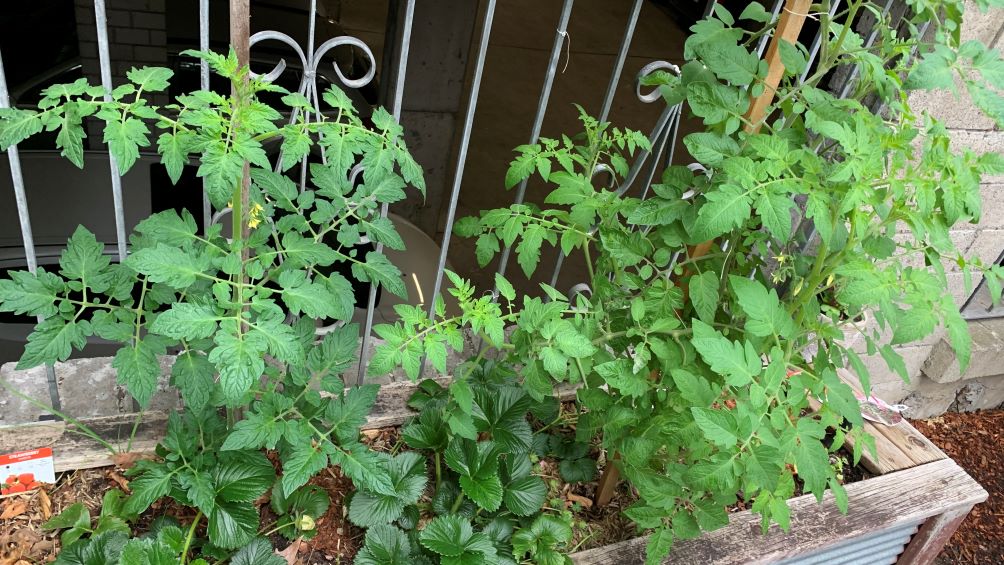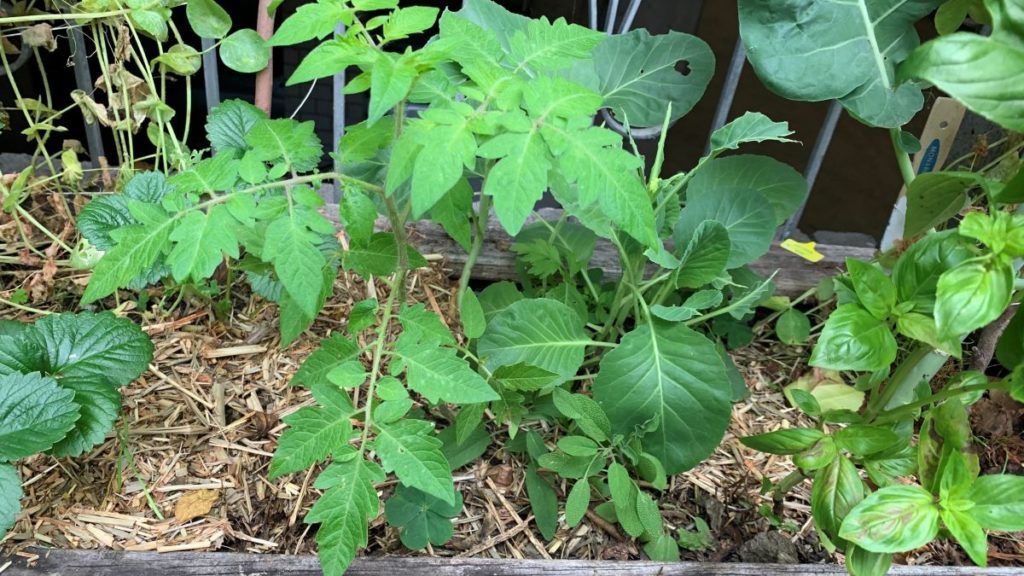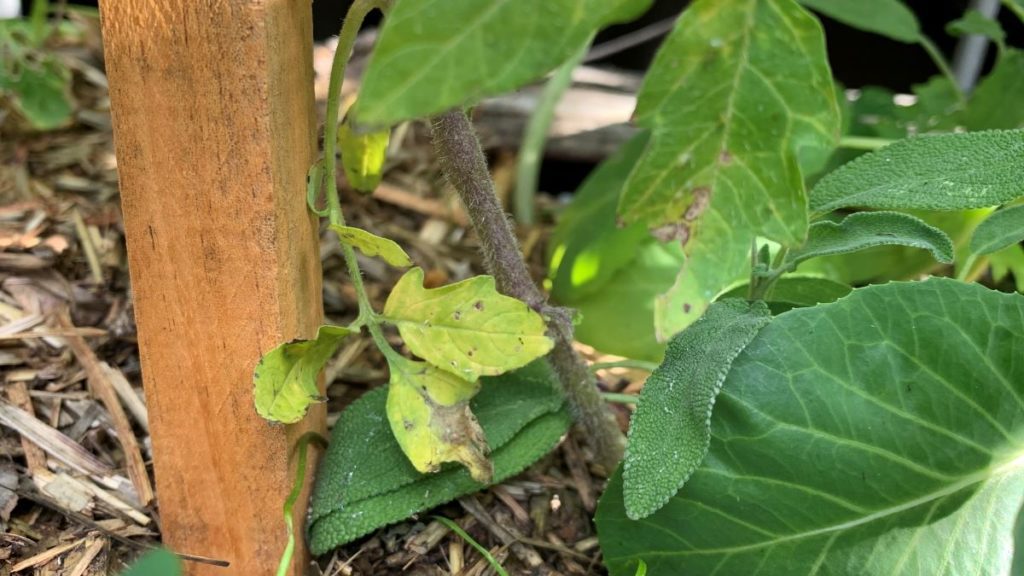Yellow leaves on tomato plants should be cut off when there are signs of fungal growth, when the leaves are touching the ground and when the leaves are near the base of the plant. The leaves at the base of indeterminant tomato plants will naturally turn brown over time. These can be pinched or snapped off.
This article will explore when to cut yellow leaves off tomato plants and the best way to do it. If the tomato stem is damaged in the process it can interrupt the plant growth and make an entry point for disease.

When to remove yellow leaves on tomato plants
Here are the top times you should cut off yellow leaves on tomato plants.
1. When there is fungal growth
The most important time to cut off yellow leaves on tomato plants is if you see fungal growth. Leaves that have yellow or brown spots or have grey sooty mold should be cut off.
Cutting these yellow leaves off serves two purposes. Removing the leaves with fungus will stop it from spreading to other leaves and up the stem. It will also allow more air movement which can help to prevent mold and fungus from infecting again.

Avoid watering tomato plants on their leaves to reduce the chance of fungal growth. Water the plant at the base around the roots to keep water off the leaves.
Fungal spores can also be splashed up onto the leaves from the soil and will grow fast if there is water on the leaves. Surround tomato plants with mulch to avoid this happening.
2. When the leaves are touching the ground
If tomato leaves have turned yellow, have drooped, and are touching the ground then it is best to remove them. Leaves that are touching the ground can transfer diseases from the soil onto the plant. Trim them off near the base of the stem.
You can usually snap the leaf off if you pull it sideways. It will come off cleanly and heal over. If the tomato leaf is showing some resistance, use sharp, clean secateurs to remove it.

3. When the leaves are near the base of the plant
Leaves that have gone yellow near the base of the tomato plant should also be removed. These leaves will naturally turn yellow and brown as the tomato grows. Indeterminant tomatoes or tomato plants that grow as vines such as beefsteak will replace old leaves at the base with new ones at the top.
Removing these leaves helps to keep the plant tidy, allow good air flow and preventing the transfer of fungus from the soil to the plant.
4. If the leaf has tears or is damaged
If the tomato leaf has been torn or damaged and is starting to turn yellow then it is best to remove it. Tomatoes can grow leaves quickly to replace the damaged leaf so it is best to remove it. Trim off the leaf near the base of the stem and allow new shoots or leaves to come through.

5. If the leaf has been attacked by pests
Pests can attack tomato leaves turning them yellow and causing damage. Aphids, thrips, spidermite and caterpillars can all chew or suck the sap from the tomato leaves.
This can cause holes and yellow marks. Treat the pests with neem oil or flick off any chewing pests like caterpillars, snails or slugs. Trim off the leaf and let the plant
NOTE: do not remove more than 1/3 of the leaf coverage of your tomato plant. Leaves damaged by pests can still photosynthesize. If your tomato plant only has a few leaves it can be a good idea to leave them on until the new leaves start to appear.
Top causes of yellow leaves on tomato plants
Here are the top reasons why you will get yellow leaves on tomato plants. It is important to know why the leaves turn yellow before cutting them off.
1. Nutrient deficiencies
Nitrogen deficiency can cause leaves on tomato plants to turn yellow. Nitrogen deficiency can occur due to poor soils, excess rainfall or overwatering. Nitrogen is essential for leaves to develop the chlorophyll in their cells which gives the leaves their green color.
Nitrogen deficiency can be solved by adding some pelleted chicken manure around your tomato plants.
Iron and magnesium deficiencies can also cause tomato leaves to turn yellow. These essential nutrients can be lacking in the soil, especially if the soil has not been improved between crops or if you have had the same crop growing in the same place over again.
2. Fungal or bacterial growth
Fungal or bacterial growth is a common cause of yellow spots on tomato leaves. This fungus can spread all over the tomato if you don’t get rid of the source. While fungicides can work it is best to try to get rid of it through pruning if you can.
Allowing more air movement and avoiding getting water on the leaves can be a great solution without using a fungicide.
3. Old or damaged leaves
Tomato plants will naturally replace lower leaves with new green ones higher up the stem. These will photosynthesize well and the old leaves will die back turning yellow and then brown. This is a natural process and is not a problem to worry about.
The best thing to do is to remove the yellowing leaves from lower down and to keep the stem clearer. This will allow more air flow, make the plant less appealing to pests and keep it bright and green.
Should you should cut off yellow leaves on tomato plants?
You should cut yellow leaves off tomato plants as they are usually damaged or old. Tomato plants will grow new green leaves fast if they are taken care of. Make sure that you treat any pest problems and remove any leaves that are affected by fungus.
Keep water off of tomato leaves and make sure the plant ahs plenty of air flow. Growing tomatoes in full sun will also help to prevent fungal growth and yellowing leaves.
Happy growing.
I am an accredited practicing dietitian, experienced gardener and a dedicated cook. I love writing and sharing my experience so you can learn from my successes and mistakes.
